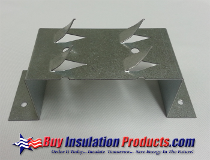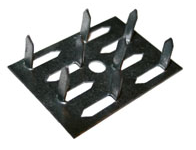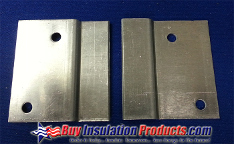
Purchase Our Products at Our Online Store At: www.BuyInsulationProductStore.com
|
ACOUSTIC WALL PANELS: Things to Keep In Mind When Building: - 2" Thick Insulation Should Be Used The largest cost of a DIY wall panel is the frame (optional), the hardware, and especially the fabric. If you are going to go through the trouble of making acoustic wall panels you should use 2" thick insulation compared to a thinner material. The price increase from a 703 1" thick panel to a 703 2" thick panel is less than $5. Don't get us wrong, if you can make 12 panels at 1" thick compared to 6 panels at 2" thick, you may have a better setup (larger surface area would win). Usually the cost of the other materials involved make that scenario unrealistic. So if you are going to make say 6 panels, you would be better served with 6 panels at 2" thick. - Leaving an Air Gap behind your wall panel is very beneficial Besides the fact that your panel will capture extra reflections bouncing from the side into the back of the panel, leaving an air gap the depth of the thickness of the panel improves the panels absorption through the front. A panel that has open air behind promotes air flow which will allow the sound waves to hit the panel at a higher velocity which will increase the absorption of the waves. A panel that is directly on the wall or has a wood backing has less air flow, so the air in the panel has no way to escape the back of the panel causing the sound waves striking the front of the panel to slow down (like hitting a wall). The slower the sound wave, the less absorption by the panel. - The type of fabric you choose may be as important as the type of insulation Most of our 2" thick insulation products will all perform very well acoustically, but the insulation may not be able to absorb as much sound due to the fabric installed over it. A tight weave fabric will cause reflection of the sound waves and basically prevent the insulation from doing its job. The best fabric will be a loose weave that is as porous as possible (burlap like). We recommend the breath test which is blowing through the fabric and making sure you can feel your breath on the other side with your hand. Holding the fabric up to a light will also show how much sound will be able to pass through. INSULATION MATERIALS FOR ACOUSTIC WALL PANELS There are two types of insulation that are commonly used for acoustic wall panels, these are fiberglass and mineralwool. Fiberglass insulation panels are made out of tiny inorganic glass fibers held together by thermosetting resin binder and preformed into rigid board that are 2ft x 4ft rectangles. Owens Corning is the premier manufacturer of fiberglass board insulation in the United States, and their board product is referred to as the 700 Series product line. The 700 Series board comes in different densities (weight of fiberglass per cubic foot). 703 is one of the more economical and efficient products with a density of 3 lbs. 705 is the professional grade acoustic board that has a density twice that of 703 at 6 lbs. Due to the higher density, 705 is much more rigid and firm than the 703 board. Due to this fact, we recommend 703 for framed panels while 705 can be used in frames and non-frame applications. Mineralwool insulation panels are made out of fibers derived from basalt rock and slag. The mineralwool boards also come in the standard 2ft x 4ft rectangle panels. Roxul is the largest mineralwool insulation manufacturers in North America. Roxul makes many different thicknesses and densities, the most common densities are 8 lbs/cf and 4 lbs/cf. Mineralwool panels are considered rigid but they do tend to be a little softer than the fiberglass panels. INSULATION PRODUCT ABSORPTION COMPARISONS The table below shows the comparisons between the most popular insulation products used in acoustic wall panels. Depending on the application, the frequencies to focus on in comparisons is the 500hz to 2,000hz.
*Differences of coefficients less than 0.15 are not significant
HARDWARE OPTIONS FOR EASY INSTALL
-MetroFlex 2" Standoff Brackets: Standoff brackets allow the same easy pushdown installation as the PushDown Impalers but they also give a 2" air gap behind the panel which allows superior absorption. 4 Brackets are used per panel (8 brackets/box (2 panels))
-MetroFlex Acoustic Impaling Clips: Acoustic Impaling Clips are the most commonly used hardware for installing acoustic wall panels. Simply install 4 impaling clips on the wall for each corner and press the panel onto the impaling clips. Use a caulking adhesive for permanent placement. (24 clips/box (6 panels))
-MetroFlex PushDown Impaler Clips: PushDown Impaler Clips have 2 sharp angled prongs to provide maximum hold of the insulation panel. Simply install 4 impalers on the wall for each corner and press the panel downward onto the impalers. (24 clips/box (6 panels))
-MetroFlex Z-Clips: Z-Clips are used for framed acoustic panels. Simply install 2 of the z-clips facing downard and out and install the other 2 z-clips on the wall facing upward and out. The acoustic panels can be put up and taken down (rearranged) in minutes. (24/box (6 panels)) CLICK HERE FOR DIY BASS TRAP PANEL GUIDE
|



